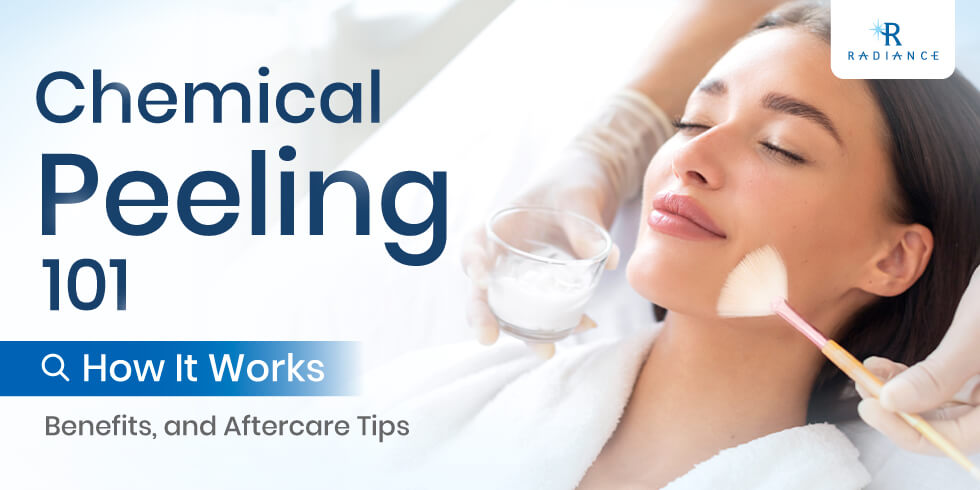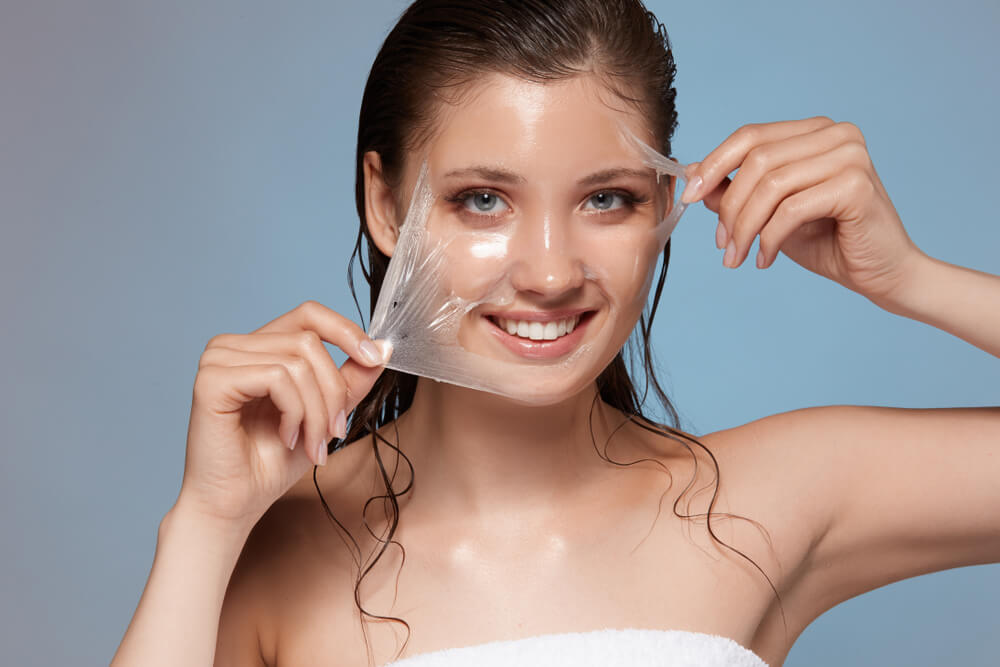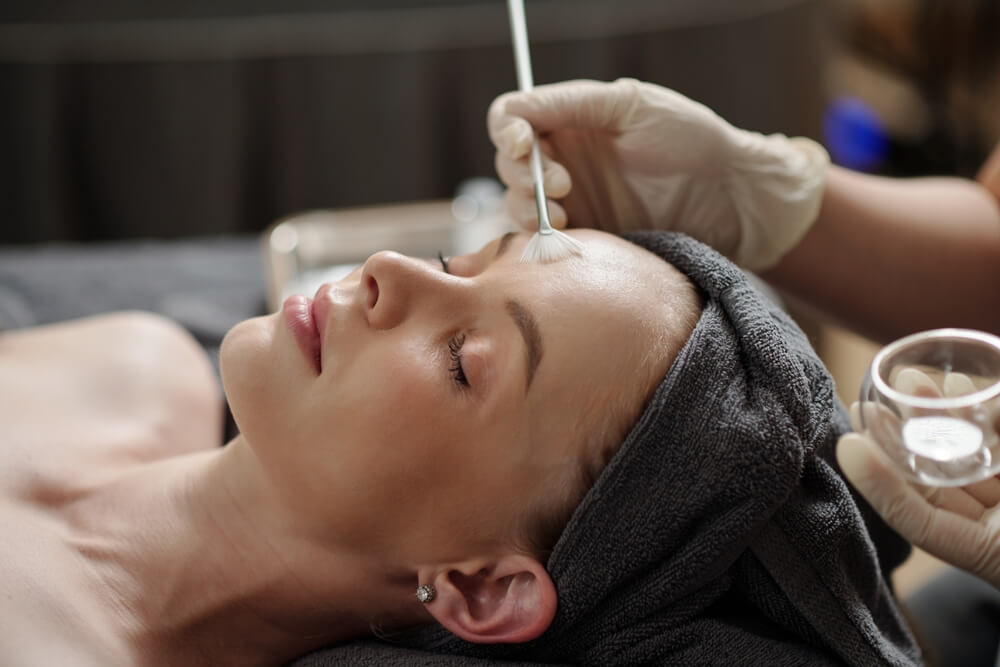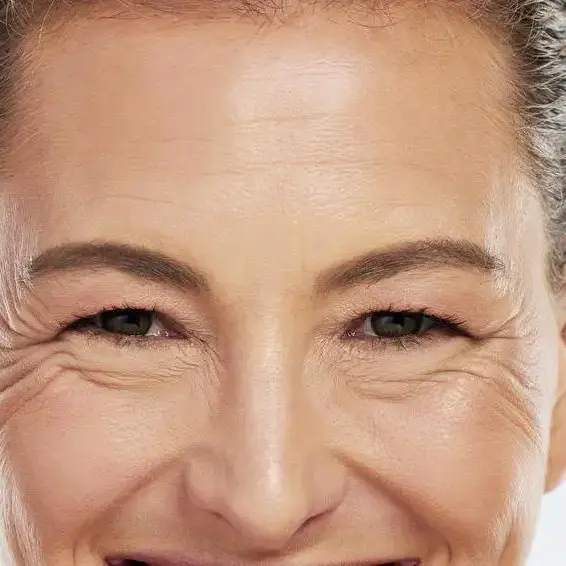
Chemical peeling has been used for aesthetic care for a hundred years for the improvement of skin conditions, from dull skin to deep damage caused by aging and the environment. Nevertheless, the word “chemical” may make some of you fear applying them. Thus, the modern dermatological field has developed the compound and procedure that allows you to have a safe and effective chemical peeling under the hands of professionals, which becomes a non-surgical option for common concerns like fine lines, wrinkles, and uneven spots.

This article will thoroughly explain the process of chemical peel treatment for dull skin and uneven skin tone to help you decide on the best option for maintaining healthy, hydrated, and radiant facial skin.
What is Chemical Peel?
Chemical peel, also known as chemexfoliation or dermapeeling, is a part of an exfoliation process using a chemical compound to “peel” off the dead skin. We had discussed earlier about peeling off the dead skin in our article about facial treatment. Those dead skin cells not only inhibit the process of skin cell regeneration but also clog your pores, which leads to acne and other facial skin complications. The frequent removal of those dead skin cells then helps you maintain healthy, hydrated, and radiant facial skin.
Chemical peel was introduced in the late 19th century by Austrian dermatologist Ferdinand Ritter von Hebra. He introduced the use of phenol, croton oil, and nitric acid for the treatment of freckles. Later, German dermatologist Paul Gerson Unna developed the use of salicylic acid, resorcinol, phenol, and trichloroacetic acid (TCA) in skin exfoliation. Then, chemical peeling became a key method of exfoliation at least until the 1900s when dermabrasion was introduced in Germany.
How is Chemical Peel different from other peels?
Currently, there are three major types of chemical peeling processes.
- Light peels or Superficial peels: Known as “lunchtime” peels, which uses glycolic acid, salicylic acid, and Jessner solution for the removal of dead skin cells only in the level of epidermis. Not only does it help bring a glow and nourishment to your skin, but light peels are also effective in dealing with fine wrinkles, acne and acne scars, and uneven skin coloring if being constantly applied.
- Medium peels: Medium peels affect deeper into the upper part of the dermis through the use of glycolic or trichloroacetic acid of 20-35% concentration, which penetrate deeper and are effective in a reduction in blotchy pigmentation, freckling, and actinic keratoses or dry sunspots. Thus, the treatment is likely to be with pain, swelling, redness, and crusting for a week, resulting in significant downtime.
- Deep peels: Deep peels penetrate to the deepest compared to others, as highly concentrated phenol peels out the cell to the dermis level. This will be used only with deep damage by the sun, deep acne scars, areas that appear blotchy, or pre-cancerous growths called actinic keratosis. Deep chemical peel usually involves some sort of pretreatment for up to eight weeks, and a request for local anesthetic and a sedative to manage any discomfort. As a result, deep peels are a one-time treatment and will be performed if considered the best option available.
As you have seen, chemical peeling differs from its mechanical exfoliation counterparts. Other than the method between chemical and mechanical means, the major difference between chemical peels and mechanical peels is their level of “peeling”, which chemical peels can deal with a deeper level of your skin. As a result, chemical peels could be an option for the treatment of acne scars, hyperpigmentation, sun-damaged skin, scars, and wrinkles, but they had to be done by a professional dermatologist.
Reading to this point, if you are looking for chemical peeling or a complete package of facial treatments, consider contacting us for additional information and consultation.

What you need to know before considering a chemical peel
One of the conditions that we had to mention about chemical peeling is its risk of darkening skin after the treatment, formally called post-inflammatory hyperpigmentation. Here, a person with dark skin, following Fitzpatrick’s scale of IV to V, should avoid chemical peels. In addition, one who had a history of abnormal scarring, had a tendency to have extra pigmentation, had skin conditions or medications that make the skin more sensitive than normal, or used certain acne treatments within the last year, is not a good candidate for chemical peel. Also, peel areas must be free of any open sores, lesions, or skin infections.
In addition, chemical peeling also comes with a risk. The major one is infection due to bacteria, yeast, or a virus, which is preventable and treatable with antibiotics. Scarring also possibly occurs from infection or picking the scabs, and can be permanent. Those with darker skin may have a chance of blotchy pigmentation. Additional complications include blocked pores or acne. For deep peels, there is a chance of potentially fatal heart rhythm disturbance and nerve damage if the compound is being used wrongly.

If you are a fit candidate for chemical peeling after the diagnosis by a dermatologist, you may require an application of “pre-treatment” night cream for several weeks. Those creams usually include tretinoin, alpha-hydroxy acids such as glycolic or lactic acid, and also hydroquinone for darker skin patients or those with melasma. High SPF sunscreen is also required during the daytime until the day of the peel.
On the day of the chemical peeling. The process began with the deep cleansing to remove surface dirt and oils. Then, painkillers and sedation are applied for medium peels, and also anaesthetics for deep peels. Later, the chemical compound is applied for several minutes before being completely cleansed out with water. Moisturizer will be applied to moisturize the skin with additional mild cream or lotion. For the deep peels, the treated area will be bandaged to protect it from the external environment.
The results of the peels differ by type of peel. Light peels result in mild facial redness and occasional swelling, which usually resolve within 48 hours. Medium and deep peels may result in intense inflammation and swelling for weeks. As a result, medium and deep peels require a full dosage of antiviral medication for between 10 and 14 days, and also prescribe painkillers. In addition, the aftercare for all peels requires that patients need to keep the treated areas cool, moisturize the treated area, and protect the treated area from the sun for months. Additional requirements may be recommended by your dermatologist.
Chemical Peel treatment at Radiance Skin Clinic
Radiance Skin Clinic, a professional aesthetic clinic located in the heart of Bangkok, currently offers you an alternative to chemical peels – the natural peel. With a substitution of chemical compounds by natural acids blended with antioxidants for safe and effective exfoliation of your epidermis under the hands of a professionally trained dermatologist. Not only a visibly improved condition of your facial skin, but our natural peel also provides the nourishment that helps your skin stay healthier in the long term.
Speaking of facial treatment, Radiance Skin Clinic offers you a vast range of facial treatment programs, ranging from a basic package that you could repeat monthly to a grand program including multiple advanced treatment programs as an annual gift for your facial skin. Our teams of professional aestheticians and dermatologists are ready to provide you with the best facial treatment experiences, while being affordable enough to bring you in for a frequent visit.
If you are living in Bangkok and currently searching for “chemical peel treatment for dull skin and uneven skin tone”, visit our team for a consultation at our clinic located at Maneeya Center between 10 am and 7 pm, or leave a message on our online channel here.
Phones and WhatsApp: (+66)82-695-2496
LINE: @radiance
Facebook: https://www.facebook.com/RadianceClinicBkk
Website: https://radianceskinclinic.com







